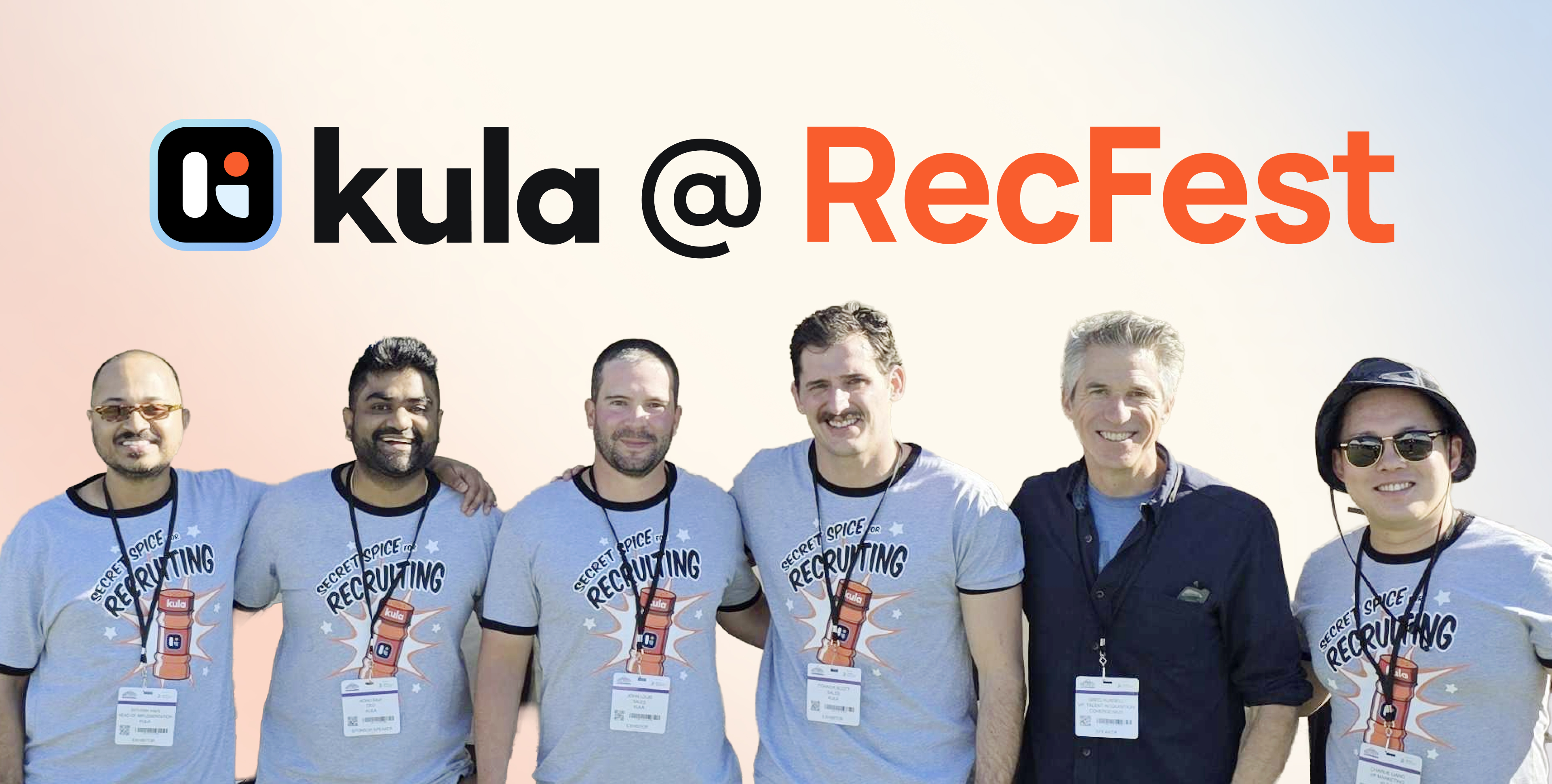Book a 30-minute demo and learn how Kula can help you hire faster and smarter with AI and automation
Undoubtedly, sourcing and hiring the right talent has become increasingly challenging, with 77% of employers struggling to fill vacancies in their company in 2023.
So, what can you do to attract, hire, and retain top candidates and make the best out of the current job pool?
The right play would be to develop a detailed talent acquisition strategy with your organizational values and culture as the core. A successful talent acquisition can:
- Build a strong pipeline with the best talent in the industry
- Define a data-driven path of sourcing, vetting, and onboarding the right people for the positions
- Create a positive employer brand and strong relationships with potential candidates
- Make recruitment cost-efficient
That’s why we’re sharing what talent acquisition means and how you can use it to build a skilled and resilient workforce.
What is talent acquisition?
Talent acquisition is the process a company or organization follows to plan its long-term talent requirements and identify, hire, and onboard qualified candidates accordingly.
It covers the entire process of hiring, right from candidate sourcing to planning compensation packages.
Some notable components of talent acquisition include:
- Recruitment
- Learning and development
- Compensation management
- Onboarding
- Succession planning
Why is talent acquisition important?
Companies can post vacancies, hold interviews, and hire candidates when needed. So why are we emphasizing talent acquisition as a long-term strategy? The reasons are as follows:
Attracting top talent
Talent acquisition strategies are designed with business goals in mind. So, it ensures that the recruiters source not only the best skilled but culturally fit talents into the pipeline.
Boosting employee retention
Effective talent acquisition strategies help businesses avoid bad hires. Recruiters pay close attention to the candidate’s core values and their alignment with the company’s mission and vision and recruit them accordingly. It results in a mutually enriching collaboration between the employer and employee and improves employee retention.
Hiring cost reduction
Besides reducing costs associated with mishires, talent acquisition also streamlines the hiring process. It helps your TA team to gauge recruitment needs early on and allocate resources accordingly.
Such methodical planning maximizes the impact of your talent acquisition initiatives while staying within the budget. Without unforeseen expenses, your hiring process becomes much more cost-effective.
Builds a diverse and innovative team
A Forbes survey noted that 56% of companies with $10 billion in annual revenues find diversity a driver of innovation. Hence, to build an innovative team, you must prioritize diversity.
A practical talent acquisition framework can help you here with DE&I policies. It reduces bias and lets companies source and hire candidates from different backgrounds, ethnicities, cultures, and sexual orientations. This creates a diverse and inclusive workforce and facilitates better innovation.
Maintaining business continuity
Sudden vacancies can hamper your team’s workflow and reduce business productivity. A proper talent acquisition strategy keeps your pipeline with top candidates.
For example, the TA team can use your ATS to access applicant repositories and fill vacancies with skilled applicants from past recruitment cycles.
Effective talent acquisition also nurtures relationships with potential candidates and makes urgent recruitment a much easier process.
Talent acquisition vs recruitment
Often used synonymously, talent acquisition and recruitment have quite a few differences. Here are some notable ones:
- Recruitment is only a component of talent acquisition, not the whole process.
- Recruitment focuses on filling current vacancies, while talent acquisition involves strategies based on long-term business goals.
- It takes more time to plan talent acquisition than recruitment.
The 5 stages of talent acquisition
The whole point of framing a talent acquisition strategy is to ensure that everyone you hire contributes to your company’s growth. So, let’s discuss the five stages of talent acquisition you must map out to get the best results:
1. Sourcing
The step step of talent acquisition is to identify the best sourcing channels and make contact with candidates. Here, companies post ads on job boards, generate leads through industry networking, contact previous applicants, etc.
Passive candidate sourcing is also a popular method of identifying skilled candidates.
TA teams also run inbound talent acquisition campaigns through referrals, content, and employer brand marketing.

Want to amplify your inbound talent acquisition and build an exclusive talent pool?
Use the AI-driven recruitment automation platform Kula’s Circles to create a seamless referral program with pre-filled templates. You can also mine the network for the best-fit candidates, introduce yourself with just one click, and optimize your outbound recruiting outreach.
2. Attracting
Once your sourcing channels are live, candidates would want to know about your company, culture, and benefits before they apply.
So, in this stage, your talent acquisition team must make the job opportunity appear lucrative. They market the compensation package, frame L&D programs, promote the company’s commitment to DE&I, etc. The goal here is to make your employer brand stand out and shine.
3. Interviewing
Now that you have candidates in your pipeline, it’s time to evaluate their skills and competence for the open role. In this stage, you screen resumes and conduct interviews with the filtered applicants.
Usually, there are several candidate screening rounds to ensure the selection of the best well-rounded candidate. Depending on the role and urgency, companies conduct group interviews, 1:1 interviews, cognitive ability and technical tests, etc. Virtual interviews have become quite popular for remote and hybrid roles.

Kula offers sophisticated ATS features like automated resume parsing, interview scheduling, and timely reminders. You can also automate recruiting workflows and ensure candidates have a positive screening experience across all stages.
4. Recruiting
In this stage, the recruiting team compares interview results, cross-checks references, and runs background checks. They also involve all the stakeholders for their input on each interviewed candidate’s competency for the role. Then, they select which candidate gets a job offer.
5. Onboarding
The company sends the selected candidates formal job offers. Once accepted, the onboarding phase starts. The recruitment team sends welcome emails, gets necessary paperwork signed, and keeps equipment ready for new hires.
This stage also involves tasks such as team introductions, clarifying responsibilities, and sharing resources.
Ultimate tips for effective talent acquisition
According to a 2023 LinkedIn report, 87% of TA experts say talent acquisition has become more strategic in the past year. So, evaluate your strategy regularly to ensure your processes are streamlined and offerings are competitive.
Wondering how to make your talent acquisition more effective and strategic? Here are our expert-recommended tips:
Define clear job requirements
If you want to attract the best candidates, tell them exactly what you need.
- List all key positions in your organization and their associated responsibilities.
- Then, build ideal candidate profiles for each. This will keep your job requirements organized and create accurate references for candidate sourcing and screening.
- Specify your requirements in detail in your job descriptions.
- Define the hard and soft skills you are looking for clearly to help potential candidates make informed decisions while applying.
Use multiple sourcing channels
Maximizing your sourcing channels gives you access to a broader talent pool. It also improves your chances of attracting the best candidates with the right skills and qualifications. You can also:
- Leverage multiple candidate sourcing channels like LinkedIn, GitHub, and social media platforms.
- Tap into your professional networks, create an employee referral program, and share your job posts on your social media channels.
- If you have the budget, run job ads on relevant platforms.
Build a strong employer brand
Ensure the best qualities of your organization shine through when a potential candidate evaluates you as an employer. To achieve this, you can:
- Create a powerful employer brand that cares about its employees, has a purpose greater than profits, and offers ample growth opportunities for its workers.
- Build a cohesive employer brand through your website, job boards, and social media presence.
Leverage Kula’s ATS’ exclusive benefits, like an out-of-the-box career site builder, and create a branded job board for your company. - Add behind-the-scenes in your office on your company’s LinkedIn profile and other social media accounts.
- Showcase employee testimonials on your job boards and career pages.
- Do not forget to celebrate your team’s achievements publicly and promote your DE&I policies and learning programs.
Streamline the application process
35% of candidates mentioned applications taking too long to fill out as one of their top frustrations. So, make the application process easy.
Kula ATS can seamlessly integrate with your sourcing channels and set up one-click application submission.
Examine your overall application process and identify what could be simplified or eliminated.
Also, 43% of candidates apply for jobs on mobile devices. So, optimize your application process for both desktops and smartphones.
Define the interview process
Build a clear trajectory for your interview process. Understand which roles require what type of evaluations. Ask yourself questions like: Would group interviews be more productive for certain jobs? Do you need to set up any special assessments to evaluate a skill?
- Design an engaging and transparent candidate experience that offers feedback as applicants move through the hiring process.
- Communicate the number of interview rounds and the estimated wait time in every stage.
- You must also define parameters for each round to keep the screening data-driven and fair for every applicant.
Offer competitive compensation and benefits
See what your contemporaries offer and create a well-thought-out package that prioritizes monetary compensation as much as work-life balance and mental well-being.
Some benefits that can attract the best candidates include:
- Life and medical insurance
- Parental leave
- Wellness programs
- Stress management sessions
- Flexible work hours
- Retirement plans
- Education sponsorship and professional courses
Evaluate industry standards regularly and update your compensation package every year.
Conclusion
To sum it up, don’t forget to:
- Use multiple candidate sourcing channels for a wider talent pool
- Define your job requirements, interview rounds, and expected timeline clearly
- Craft a competitive compensation plan and update it to match industry standards and inflation
- Keep the application process quick and simple
- Ensure a cohesive and streamlined candidate experience across the recruitment funnel.
From forecasting hiring needs to designing an attractive benefits plan, mapping effective talent acquisition can be a hard nut to crack. But with a suitable ATS, the process can become much smoother.
With Kula ATS’ automated recruitment workflow, career page builder, and interview scheduling, you will have everything you need to implement a streamlined talent acquisition plan.
Sign up for a free trial and maximize your recruitment potential today!






















